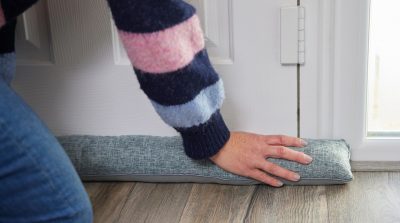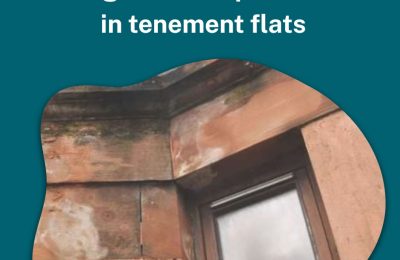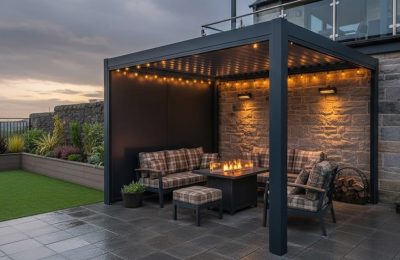As the nights grow longer and the air turns cooler, it’s time to start thinking about how to keep your property warm and dry this winter. One effective way to do this is by making energy efficiency improvements.
Enhancing your property’s energy efficiency can help reduce fuel costs, make your home more comfortable, and support environmental sustainability. If you’re a landlord, it can also ensure you’re meeting private rental regulations. However, it’s essential to approach these improvements carefully to avoid inadvertently causing dampness in the building.
This article will cover key energy efficiency improvements to consider for winter, principles to keep in mind during the process, and special considerations for traditional buildings.
Tackling draughts
Improving energy efficiency doesn’t always require major renovations. One of the simplest yet most effective steps is tackling draughts. Draughts can significantly impact your flat’s warmth and increase your heating bills, so addressing them is a crucial part of preparing your property for winter.
Draughts often occur when seals around doors and windows are damaged, or due to issues with chimney flues. Start by making a list of potential draught sources. Common areas to check include:
- Windows and doors: Look for gaps around the edges, damaged seals, or loose fittings.
- Skirting boards: Check for gaps or cracks where the skirting meets the wall or floor.
- Chimneys: Traditional tenements with chimneys may experience draughts if the flue isn’t properly sealed.
Signs of draughts include noticeable cold spots, cracks, gaps, and even mould or dampness around the affected areas. These indicators suggest that warm air is escaping and cold air is entering, making your flat less comfortable and more costly to heat.
For many draught issues, simple DIY solutions can be quite effective. Here are some steps you can take:
- Sealing gaps: Use draught-proofing strips or sealants available at hardware stores to fill gaps around windows, doors, and skirting boards.
- Thermal curtains: Installing thermal or draught-proof curtains can help to keep cold air out and warmth in.
- Chimney balloons: For unused chimneys, consider using a chimney balloon or draught excluder which can be inflated inside the flue. It’s important, however, not to block the flue entirely. Unused flues should remain vented to prevent dampness and ensure that hidden areas behind wall linings stay dry.
Adding insulation
Another improvement to consider is insulation. Adding insulation is a bigger task than draught-proofing but can be worthwhile if you are in a position to do so. There are several options for adding insulation that will depend on your type of building and the position of your flat.
For adding internal insulation in flats with solid stone masonry or brick walls, there are three main options, including:
- insulation applied on existing wall linings – useful for exposed walls;
- insulation applied directly to masonry or plaster – used where walls are ’plastered on the hard;
- insulation held in place by timber framing – used where all wall linings have been removed.
For cavity wall and concrete wall constructions, other options may be suitable.
If you own a ground floor flat, adding underfloor insulation can make a big difference to your flat’s warmth. Again, the options available will depend on your floors’ construction. If you have timber floors, you may be able to insulate the space under the floor, whereas if you have a solid floor, insulation can be laid on top.
If you own a top floor flat, you may want to consider adding loft insulation. 25% of heat loss can occur through the roof. It’s essential when adding loft insulation to maintain a balance between adequate depth of insulation and good ventilation. Additionally, check for any roof leaks beforehand, as damp insulation will not work effectively. Adding insulation is treated as maintenance and therefore generally requires a majority decision from all the owners. However, before adding loft insulation, confirm whether the loft space is individually or commonly owned by checking your title and the Tenements (Scotland) Act 2004.
You might feel confident tackling insulation upgrades on your own, but for such significant work, it is worth seeking professional guidance. Expert advice can help ensure any upgrades made are effective and prevent potential issues like dampness.
Important principles to keep in mind
When making energy efficiency improvements to your home, there are several important principles to consider to ensure that any upgrades you make have the desired effect and do not lead to unwanted issues such as damp. These include:
- Thermal bridging: This occurs where areas of walls are much colder than others, often due to lack of insulation around joist ends or pipe boxes. It can lead to condensation, damp, and mould growth. To minimise thermal bridging, make sure insulation covers even difficult corners.
- U-values: Materials are often rated by their U-value, measuring how well they insulate. When choosing materials for insulation, the important thing to note in making comparisons is that the lower the U-value, the less heat is lost.
- Ventilation: While insulation reduces drafts, some ventilation is still needed to keep your home dry and the air fresh. It’s important to make sure that lofts, chimneys, and underfloor voids still have adequate airflow. Mechanical ventilation can also be used.
- Considerations for pipes and wiring: When installing any type of insulation, make sure it is placed beneath pipes to keep them within the warm zone. Electric cables should be routed below the insulation to prevent overheating.
By keeping these principles in mind, this can ensure you gain the maximum benefit from any improvements you make and do not cause other problems down the line.
Considerations for traditional buildings
Traditional stone and brick buildings are unique and differ from modern constructions like timber frames, meaning special considerations need to be made when enhancing their energy efficiency. These older structures typically feature lath and plaster linings, which are set apart from the stone or brick walls to provide insulation. However, when the stonework becomes damp, insulation performance decreases significantly. Keeping the stone dry is crucial, as it allows the building to ‘breathe’, ensuring better insulation and warmth.
To better maintain a warm, dry building:
- keep gutters and downpipes clear, well-painted, and functioning to prevent rain from soaking the walls;
- always use breathable materials, such as lime mortar, to allow moisture to evaporate;
- ensure proper ventilation to reduce moisture, prevent condensation, and stop mould growth.
Preparing your property for winter by improving its energy efficiency is a good investment for both comfort and sustainability. By addressing draughts, adding insulation, and following key principles such as proper ventilation and moisture management, you can make your property warmer and more efficient while preventing issues like dampness. Whether you live in a modern building or a traditional stone property, taking these steps will help you or your tenants stay warm and reduce energy costs throughout the colder months. For more information on energy efficiency improvements to make to your flat, see this article.
Photo credit: © AndreyPopov from Getty Images











